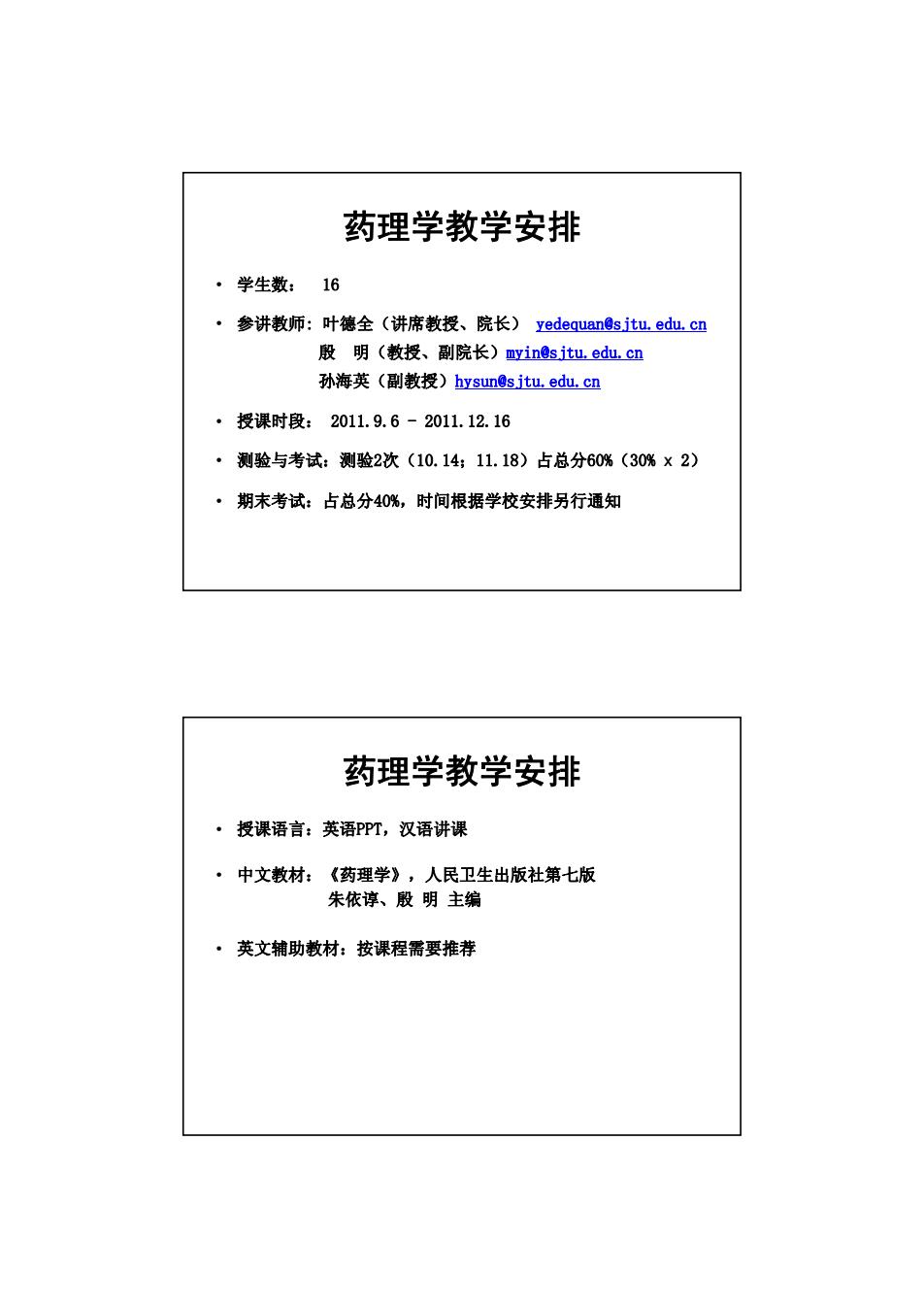
药理学教学安排 学生数:16 ·参讲教师:叶德全(讲席教授、院长)yedequan@(sjtu,edu,cn 殷明(教授、副院长)myin@s jtu.edu.cn 孙海英(副教授)hysun@sjtu,edu,cn ·授课时段:2011.9.6-2011.12.16 测验与考试:测验2次(10.14;11.18)占总分60%(30%×2) ·期末考试:占总分40%,时间根据学校安排另行通知 药理学教学安排 授课语言:英语PPT,汉语讲课 中文教材:《药理学》,人民卫生出版社第七版 朱依谆、殷明主编 英文辅助教材:按课程需要推荐
药理学教学安排 • 学生数: 16 • 参讲教师: 叶德全(讲席教授、院长) yedequan@sjtu.edu.cn 殷 明(教授、副院长)myin@sjtu.edu.cn 孙海英(副教授)hysun@sjtu.edu.cn • 授课时段: 2011.9.6 - 2011.12.16 • 测验与考试:测验2次(10.14;11.18)占总分60%(30% x 2) • 期末考试:占总分40%,时间根据学校安排另行通知 药理学教学安排 • 授课语言:英语PPT,汉语讲课 • 中文教材:《药理学》,人民卫生出版社第七版 朱依谆、殷 明 主编 • 英文辅助教材:按课程需要推荐
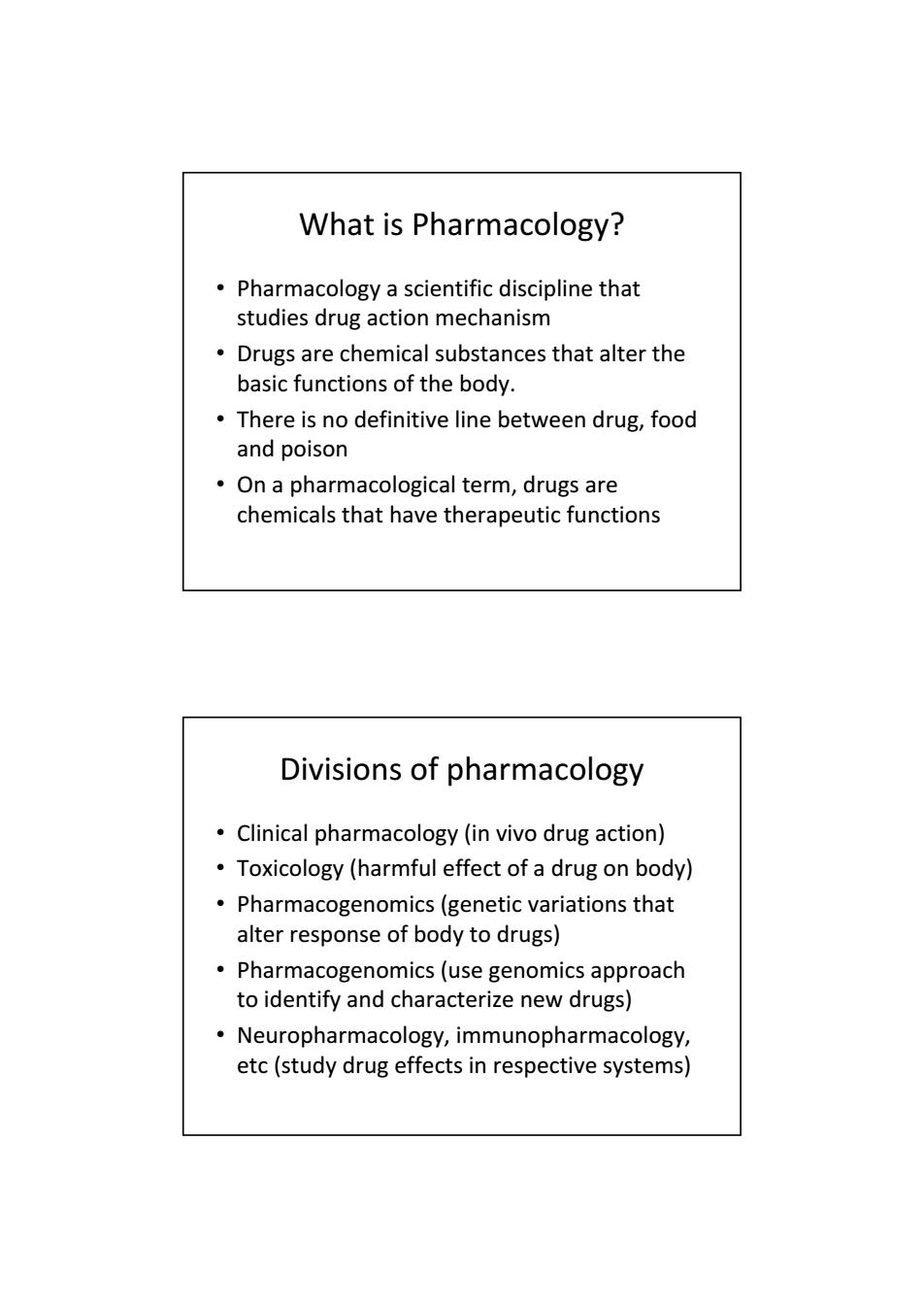
What is Pharmacology? Pharmacology a scientific discipline that studies drug action mechanism Drugs are chemical substances that alter the basic functions of the body. There is no definitive line between drug,food and poison On a pharmacological term,drugs are chemicals that have therapeutic functions Divisions of pharmacology Clinical pharmacology (in vivo drug action) Toxicology(harmful effect of a drug on body) Pharmacogenomics(genetic variations that alter response of body to drugs) Pharmacogenomics(use genomics approach to identify and characterize new drugs) Neuropharmacology,immunopharmacology, etc(study drug effects in respective systems)
What is Pharmacology? • Pharmacology a scientific discipline that studies drug action mechanism • Drugs are chemical substances that alter the basic functions of the body. • There is no definitive line between drug, food and poison • On a pharmacological term, drugs are chemicals that have therapeutic functions Divisions of pharmacology • Clinical pharmacology (in vivo drug action) • Toxicology (harmful effect of a drug on body) • Pharmacogenomics (genetic variations that alter response of body to drugs) • Pharmacogenomics (use genomics approach to identify and characterize new drugs) • Neuropharmacology, immunopharmacology, etc (study drug effects in respective systems)
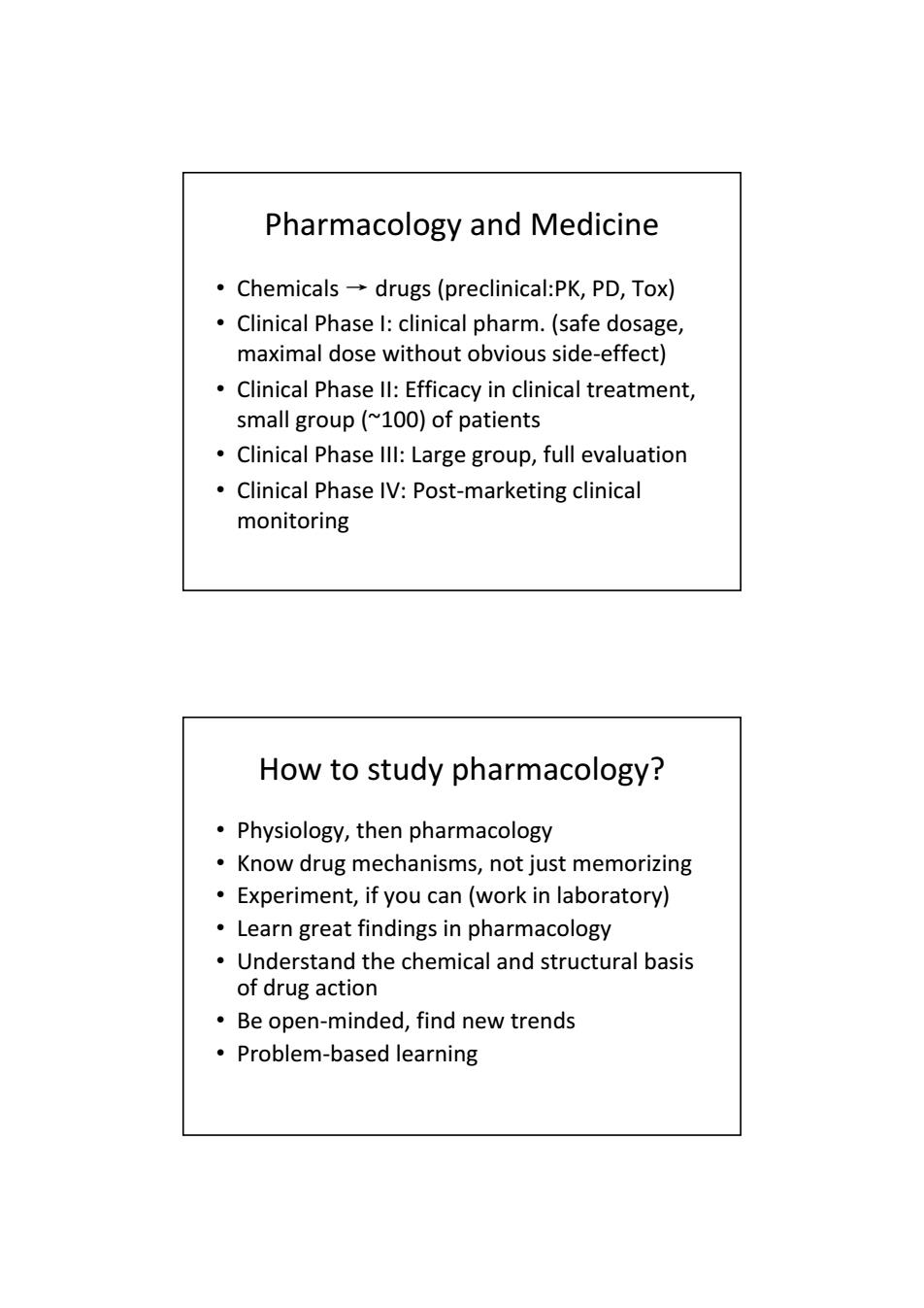
Pharmacology and Medicine ·Chemicals→drugs(preclinical::PK,PD,Tox) Clinical Phase I:clinical pharm.(safe dosage, maximal dose without obvious side-effect) Clinical Phase ll:Efficacy in clinical treatment, small group(~100)of patients Clinical Phase Ill:Large group,full evaluation Clinical Phase IV:Post-marketing clinical monitoring How to study pharmacology? Physiology,then pharmacology Know drug mechanisms,not just memorizing Experiment,if you can(work in laboratory) Learn great findings in pharmacology Understand the chemical and structural basis of drug action Be open-minded,find new trends Problem-based learning
Pharmacology and Medicine • Chemicals → drugs (preclinical:PK, PD, Tox) • Clinical Phase I: clinical pharm. (safe dosage, maximal dose without obvious side‐effect) • Clinical Phase II: Efficacy in clinical treatment, small group (~100) of patients • Clinical Phase III: Large group, full evaluation • Clinical Phase IV: Post‐marketing clinical monitoring How to study pharmacology? • Physiology, then pharmacology • Know drug mechanisms, not just memorizing • Experiment, if you can (work in laboratory) • Learn great findings in pharmacology • Understand the chemical and structural basis of drug action • Be open‐minded, find new trends • Problem‐based learning

Pharmacokinetics Drug disposition ADME ·Absorption ·Distribution Metabolism(biotransformation) ·Excretion Quantification of drug concentration in the body,and mathematic modeling ADME of a drug taken orally Oral administration Blood Bound drug Gut_ Absorption Free drug Metabolite Excretion Urine Target organ Liver
Pharmacokinetics • Drug disposition = ADME • Absorption • Distribution • Metabolism (biotransformation) • Excretion • Quantification of drug concentration in the body, and mathematic modeling ADME of a drug taken orally
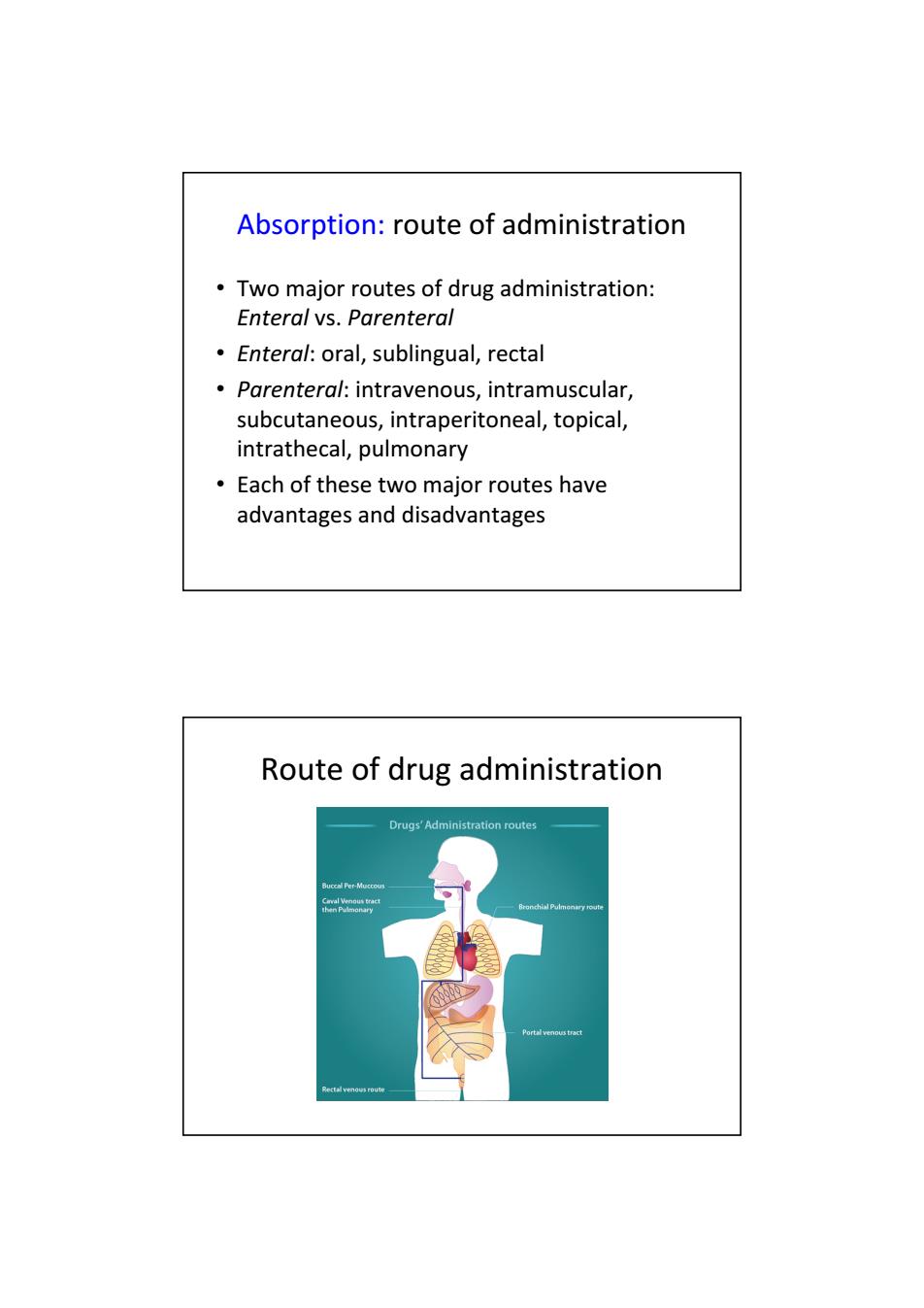
Absorption:route of administration Two major routes of drug administration: Enteral vs.Parenteral Enteral:oral,sublingual,rectal Parenteral:intravenous,intramuscular, subcutaneous,intraperitoneal,topical, intrathecal,pulmonary Each of these two major routes have advantages and disadvantages Route of drug administration Drugs'Administration routes Buc Per-Mucco Rectal venous route
Absorption: route of administration • Two major routes of drug administration: Enteral vs. Parenteral • Enteral: oral, sublingual, rectal • Parenteral: intravenous, intramuscular, subcutaneous, intraperitoneal, topical, intrathecal, pulmonary • Each of these two major routes have advantages and disadvantages Route of drug administration
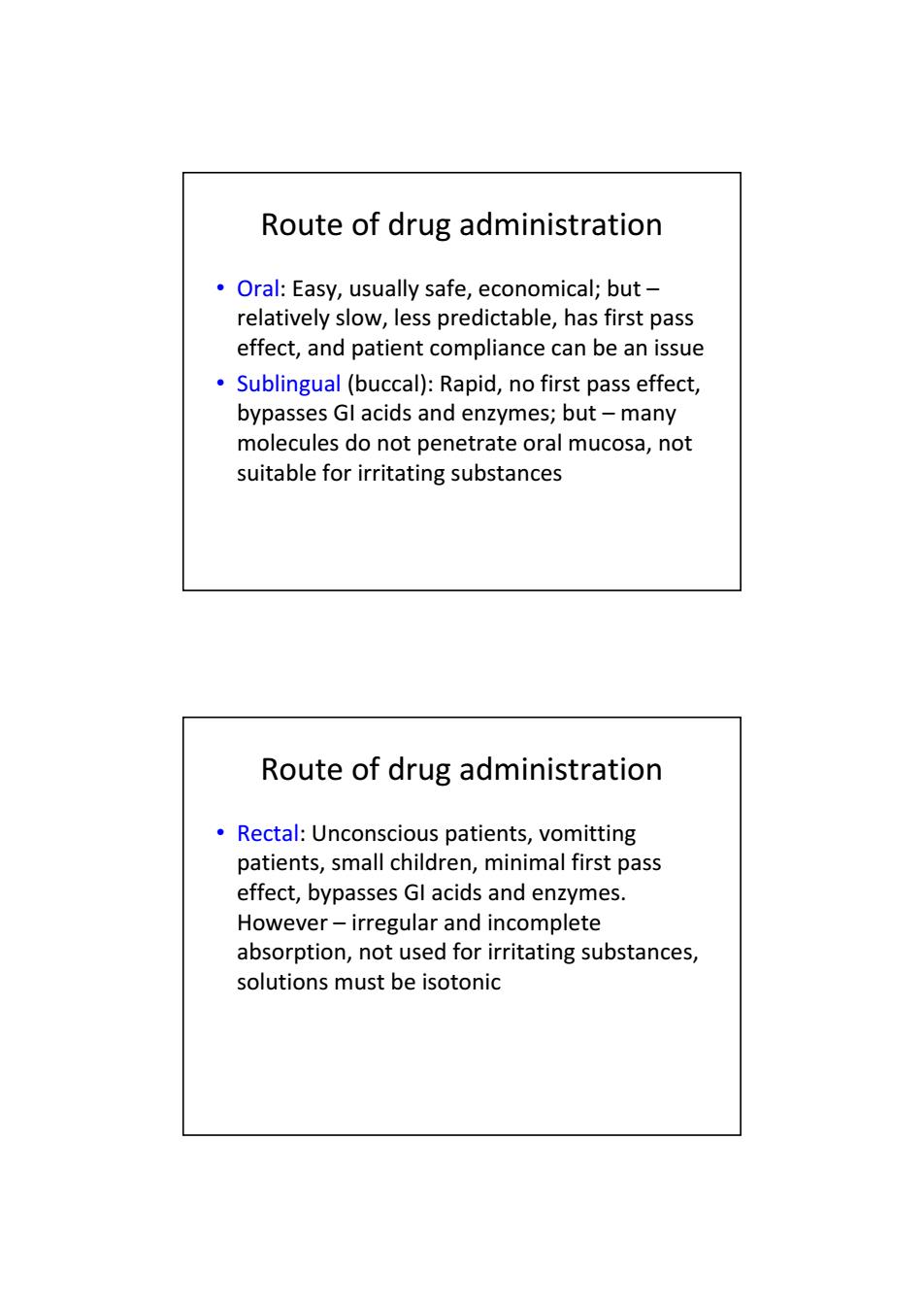
Route of drug administration Oral:Easy,usually safe,economical;but- relatively slow,less predictable,has first pass effect,and patient compliance can be an issue Sublingual(buccal):Rapid,no first pass effect, bypasses Gl acids and enzymes;but-many molecules do not penetrate oral mucosa,not suitable for irritating substances Route of drug administration Rectal:Unconscious patients,vomitting patients,small children,minimal first pass effect,bypasses Gl acids and enzymes. However-irregular and incomplete absorption,not used for irritating substances, solutions must be isotonic
• Oral: Easy, usually safe, economical; but – relatively slow, less predictable, has first pass effect, and patient compliance can be an issue • Sublingual (buccal): Rapid, no first pass effect, bypasses GI acids and enzymes; but – many molecules do not penetrate oral mucosa, not suitable for irritating substances Route of drug administration • Rectal: Unconscious patients, vomitting patients, small children, minimal first pass effect, bypasses GI acids and enzymes. However – irregular and incomplete absorption, not used for irritating substances, solutions must be isotonic Route of drug administration

Route of drug administration Drugs'Administration routes then Pulmonary Recta venous route Route of drug administration Intravenous (i.v.):Most rapid response,permits titration of dosage,most suitable for irritating substances and large volumes,lowest intra- individual variability.But-greatest risks,overdose, anaphylaxis,infection,embolism,vascular injury, extravasion Intramuscular(i.m.):Moderate volumes,faster absorption than S.C.But-nt used for irritating substances,sterile abscesses,may interfere with diagnostic tests
Route of drug administration • Intravenous (i.v.): Most rapid response, permits titration of dosage, most suitable for irritating substances and large volumes, lowest intra‐ individual variability. But – greatest risks, overdose, anaphylaxis, infection, embolism, vascular injury, extravasion • Intramuscular (i.m.): Moderate volumes, faster absorption than S.C. But – nt used for irritating substances, sterile abscesses, may interfere with diagnostic tests Route of drug administration
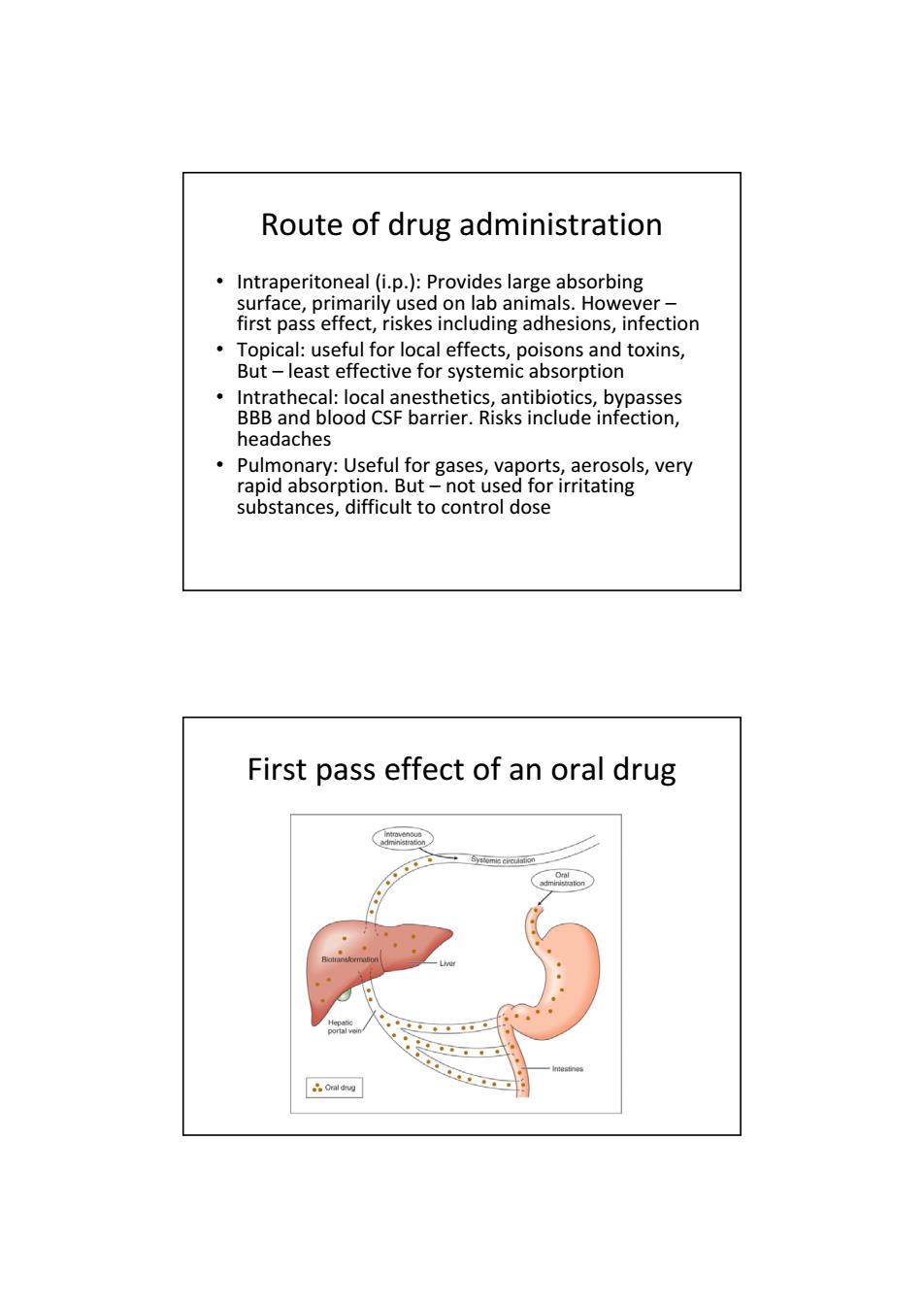
Route of drug administration Intraperitoneal(i.p.):Provides large absorbing surface,primarily used on lab animals.However- first pass effect,riskes including adhesions,infection Topical:useful for local effects,poisons and toxins, But-least effective for systemic absorption Intrathecal:local anesthetics,antibiotics,bypasses BBB and blood CSF barrier.Risks include infection, headaches Pulmonary:Useful for gases,vaports,aerosols,very rapid absorption.But-not used for irritating substances,difficult to control dose First pass effect of an oral drug Oral drug
• Intraperitoneal (i.p.): Provides large absorbing surface, primarily used on lab animals. However – first pass effect, riskes including adhesions, infection • Topical: useful for local effects, poisons and toxins, But – least effective for systemic absorption • Intrathecal: local anesthetics, antibiotics, bypasses BBB and blood CSF barrier. Risks include infection, headaches • Pulmonary: Useful for gases, vaports, aerosols, very rapid absorption. But – not used for irritating substances, difficult to control dose Route of drug administration First pass effect of an oral drug

First pass effect When a drug is administered orally,the drug is absorbed by the mesenteric veins.These veins drain into the portal vein which flows into the hepatic sinusoids.For some drugs,a substantial portion of the dose is removed and metabolized by the hepatocytes in its first pass through the liver before the drug enters the systemic circulation.Also evidence that significant first pass metabolism can occur in Gl epithelial cells. The rectal route of administration demonstrates a minimal first pass effect. If equieffective doses are administered,the following rank order describes the speed of effect: IV>IM>SC>Oral and the following rank order describes the duration of the effect: Oral>SC>IM>IV Absorption:drug transport Movement of Drugs across membranes: Active Transport:i)energy dependent;ii)saturable;ii) against an electrochemical gradient;iv)selective carrier- mediated Facilitated Diffusion:i)requires NO energy;ii)saturable;iii) NEVER against an electrochemical gradient;iv)selective carrier-mediated. Pinocytosis:Drugs of large molecular weight(MW>900)may enter cells by pinocytosis or phagocytosis. Passive Diffusion:This is the MOST COMMON mechanism for drug transport.Lipid-soluble drugs permeate across the cell membrane by passive diffusion between the lipid molecules of the cell membrane
First pass effect • When a drug is administered orally, the drug is absorbed by the mesenteric veins. These veins drain into the portal vein which flows into the hepatic sinusoids. For some drugs, a substantial portion of the dose is removed and metabolized by the hepatocytes in its first pass through the liver before the drug enters the systemic circulation. Also evidence that significant first pass metabolism can occur in GI epithelial cells. • The rectal route of administration demonstrates a minimal first pass effect. • If equieffective doses are administered, the following rank order describes the speed of effect: IV > IM > SC > Oral and the following rank order describes the duration of the effect: Oral > SC > IM > IV Absorption: drug transport • Movement of Drugs across membranes: • Active Transport: i) energy dependent; ii) saturable; iii) against an electrochemical gradient; iv) selective carrier‐ mediated. • Facilitated Diffusion: i) requires NO energy; ii)saturable; iii) NEVER against an electrochemical gradient; iv) selective carrier‐mediated. • Pinocytosis: Drugs of large molecular weight (MW > 900) may enter cells by pinocytosis or phagocytosis. • Passive Diffusion: This is the MOST COMMON mechanism for drug transport. Lipid‐soluble drugs permeate across the cell membrane by passive diffusion between the lipid molecules of the cell membrane

Effect of pH on absorption of weak acids and bases The extent of ionization(the pH of the environment and the pK of the drug). UNPROTONATED FORM(R) pH-pKa log PROTONATED FORM(RH) Gastric absorption:The pH of gastric juice is low (1 to 3).Weak bases will be ionized and will be poorly absorbed.Weak acids will be unionized and will be absorbed well.Furthermore,weak bases--even if they are administered IV--may cross the capillaries and the gastric mucosa and enter the gastric juice where they become ionized and trapped.They may be absorbed later when they reach the intestines. Intestinal absorption:The pH of intestinal juice is more basic than gastric juice(5 to 6).Here most weak bases will be unionized and will be readily absorbed.In contrast,most weak acids will be ionized and will be poorly absorbed. ABSORPTION OF A WEAK ACID (pKa 4.4) 一一● GASTRIC JUICE (pH =1.4) -” PLASMA (pH 7.4) 一● RCOOH RCOOH 一◆ ●一● ●● RCOO ●一● RCOO 1.4.4.4=18 IRC00】 =3 7.4·4.4=1og IRcoo ]3 [RCOOH] [RCOOH] 1RC00】= 0.001 RCO0】 1000 [RCOOH] 1 [RCOOH] 1 SUM IN GASTRIC JUICE 1.001 SUM IN PLASMA 1001 GASTRIC JUICE PLASMA 1.001:1001
Effect of pH on absorption of weak acids and bases